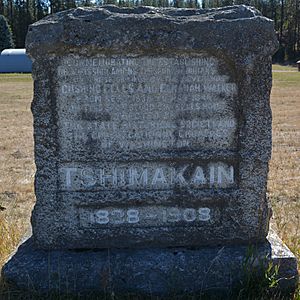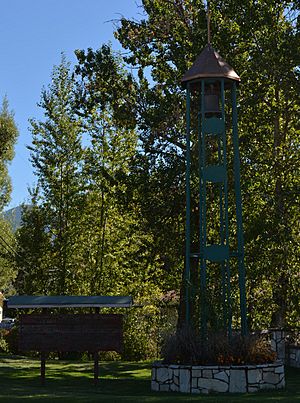Tshimakain Mission facts for kids
The Tshimakain Mission was a special place started in September 1838. It was founded by two missionary couples: Cushing and Myra Fairbanks Eells, and Elkanah and Mary Richardson Walker. They came to an area near Chamokane Creek in what is now Ford, Washington. A leader from Fort Colville, Archibald McDonald, suggested this spot to them.
The Eells and Walkers began their long journey to the Oregon Country on April 23, 1838. They traveled with a group of fur traders. They arrived at the Whitman Mission in August 1838. For the next nine years, these missionaries lived with the Spokane people. They were supported by the American Board of Commissioners for Foreign Missions.
On September 16, 1838, Cushing Eells held the first Protestant church service in Stevens County. This happened in Chewelah.
In the fall of 1839, the missionaries opened a school for local Native American children. It started with 30 students and grew to 80 over the winter.
On January 11, 1840, Cushing Eells' house burned down. Local Native Americans quickly helped them. When Archibald McDonald, the leader at Fort Colvile, heard about the fire, he sent four men to help fix the house.
In 1842, Elkanah Walker, with help from Cushing Eells, printed the Spokane Primer. This was a book to teach the Salish language. It was the first book ever written in Washington.
The winter of 1846-47 was very harsh. It was the coldest winter anyone could remember. Many animals belonging to both the Native Americans and the missionaries died because of the cold.
Contents
How the Whitman Massacre Affected the Mission
On November 29, 1847, a terrible event happened at the Whitman Mission in Walla Walla. Members of the Cayuse tribe attacked the mission. Cushing Eells and Elkanah Walker were supposed to be at the Whitman Mission that day. However, Elkanah Walker became sick. Cushing Eells did not want to leave their families without help. So, they stayed at Tshimakain.
As volunteers from Oregon chased the Cayuse people, they came closer to the Tshimakain Mission. One of the Cayuse people involved in the attack had family living near Chewelah. John Lee Lewes, a leader from the Hudson Bay Company's Fort Colvile, offered to let the missionaries stay at the fort for safety.
At first, the missionaries did not want to leave. The Spokane people wanted them to stay and offered to protect them. But as the chase for the Cayuse continued, the missionaries finally decided to go to the fort for their safety.
Colonel Henry A. G. Lee of the Oregon Volunteers asked for people to help bring the Tshimakain missionaries to safety. Major Joseph Magone and 60 volunteers helped the Eells and Walker families. They escorted them to Oregon City on June 22, 1848.
Coming Back to Tshimakain
In July 1874, Cushing Eells returned to the area. He was the only one of the four original missionaries to come back. The next Sunday, Eells held two church services for the Native Americans. He also held two more for the white settlers in Chewelah. Eells talked with John A. Simms, who was the Indian agent for the area and lived in Chewelah.
In 1892, a church was built in Chewelah. Even though Eells was living far away, he came to offer a prayer in the new church. This was 54 years to the day after he first camped at the mission site. He also gave a bell to this church. He bought the bell in New York just a few days before he passed away.
During their time with the Spokane people, the missionaries taught their faith. However, they did not have anyone convert to their faith at that time. But in the spring of 1873, Spokane Garry invited Reverend Henry H. Spalding to visit the area. That summer, Spalding baptized 253 adults and 81 children.
Walker's Prairie
The area where the mission was located is still called Walker's Prairie today. This name honors Elkanah and Mary Walker. The mission was on the main road that connected Walla Walla to Colville. This road, called the Fort Walla Walla–Fort Colville Military Road, ran right in front of their homes.
People Who Visited the Mission
Many interesting people visited the Tshimakain Mission:
- Dr. Marcus Whitman came several times. He helped Mary Walker and Myra Eells when their children were born.
- Henry H. Spalding, another missionary, visited often.
- Francis Ermatinger was part of a fur trading group. He visited in January 1839.
- Lieutenant Robert E. Johnson of the United States Exploring Expedition visited in June 1841.
- Horatio Hall, also from the United States Exploring Expedition, arrived in September 1841.
- Father Pierre-Jean_De_Smet visited in April 1842.
- Karl (Charles) A. Geyer, a German botanist, visited from December 1844 to August 1845.
- Paul Kane, a famous artist known for his paintings of Native Peoples, visited in September 1847.
More Information
- Cushing Eells collection at the Whitman College and Northwest Archives, Whitman College.



